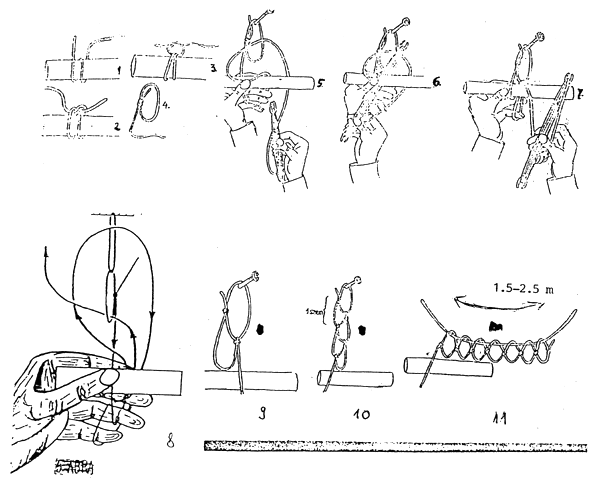| Species | Number of fish (individuals) | Weight of fish (kg) | Average weight (kg) |
| Common carp | 225 | 110 | 0.4 |
| Silver carp | 100 | 90 | 0.9 |
| Grass carp | 150 | 200 | 1.3 |
| Bighead carp | 120 | 60 | 0.5 |
The cultivable pond-fish species of the Centre in order of importance are:
| Common carp | - | Cyprinus carpio |
| Grass carp | - | Ctenopharyngodon idella Val. |
| Catla | - | Catla catla |
| Rohu | - | Labeo rohita |
| Mrigal | - | Cirrhina mrigala |
| Silver carp | - | Hypophthalmichthys molitris Val. |
| Bighead carp | - | Aristichthys nobilis |
These fish species, when cultured in a properly stocked polyculture, give high production, because they consume different types of natural food in the pond, which grows there thanks to proper fertilization.
Feeding habits and the most important food of the above-mentioned species are:
COMMON CARP is an omnivorous fish species. Insects, plankton, seeds of aquatic cultivated plants, sometimes tadpoles, fish-seed and artificial feed are also consumed by common carp. It is a bottom, column and surface feeder. It is important to include common carps in each pond, because they dig the mud and help ensure light does not penetrate to the bottom. If there is no light penetration, aquatic plants cannot grow even if large amounts of manure or fertilizer are used.
GRASS CARP is a herbivorous fish species. It consumes aquatic and terrestrial plants and artificial feed, and sometimes tadpoles and seedfish. The species is a column, bottom and surface feeder. (Grass carp does not eat all species of plants.)
CATLA feeds on zooplankton, phytoplankton and detritus. It is mainly a surface and column feeder.
ROHU consumes macrovegetation, decayed macrovegetation and plankton. It is a column feeder.
MRIGAL is an omnivorous fish species. It consumes plankton, macro-vegetation, semi-rotten macrovegetation and decayed vegetation. This species is a bottom feeder.
In the early stages of their life, the above-mentioned species all consume small-sized zooplankton (Rotifera) or Paramecium, due to their small mouth and less developed sensory organs. After the early fry phases (10–15 days after hatching) fry can accept bigger zooplankton (Cladocera, Copepoda). Advanced fry (3–4 weeks old) gradually change their feeding habits, and the fingerlings consume the same food like the adults.
In cases when there is overstocking or lack of manuring or feeding, there is a serious competition for food between the above-mentioned species. Planning of the stocking rate of big fingerling ponds or market-size fish ponds has to take account of the competition for food between:
Common carp and bighead carp
Common carp and grass carp
Common carp and mrigal
The above-mentioned species can be reproduced by seminatural and artificial methods. The most important method of reproduction and quantities are given in Table 1.
Transport of Larvae and Stocking of Nursing Ponds
Larvae should be stocked soon after the appearance of their swim-bladder. This is the time when the fish needs food, even though it still has the yolk. Even a brief period of starvation can result in mortality. Transport of larvae from the hatchery to the ponds is best done in buckets, with 20 000–25 000 swim-up fry in one bucket. For longer transport (4–5 hours) 30 000–50 000 fry is put into a plastic bag (containing about 10 litres of water and 30 litres of oxygen). On delivery a sheet of canvas should be placed on the floor of the truck under the plastic bags to avoid tearing the bags. The best method is to sit the bags in plastic bowls. The bags should always be turned with the opening to the floor to avoid oxygen escaping. Bags should be moved such that they are shaded from the sun.
The larvae should be stocked in properly prepared ponds with a well-developed Rotifera population and released near the dikes where there are grasses or aquatic plants. At the same time it is useful to put in the pond a hapa containing a small part of the larval population (some hundred fry) to check the survival rate after stocking.
The stocking density in the nursing ponds is 100 000–200 000/1 000 m2. The ponds must be stocked with larvae born the same day to avoid differences in fingerling sizes at the time of harvesting.
The nursing period lasts about 25–30 days. By the end of this phase the fish are 30–35 mm long, and the average weight is 1.5–2.0 g/individual. Survival rate depends on the handling of the larvae and proper preparing of the ponds; it is usually between 10 and 50 percent.
When the growing of market-size fish is planned in one phase (i.e., nursing and fingerling phases are omitted), about 30 000 swim-up fry/1 000 m2 can be calculated.
Table 1
BASIC DATA OF REPRODUCTION OF CULTIVATED FISH
| Common carp | Grass carp | Rohu | Catla | Mrigal | Bighead carp | Silver carp | |
| 1 | 2 | 3 | 4 | 5 | 6 | 7 | |
| Age of maturity year ♀ | 1.5 | 3.5 | 3.0 | 3.0 | 2.0 | 4.0 | 3.0 |
| Spawning season | Feb-March July-Aug. | March-Apr. | June-July | June-July | June-July | March-Apr. | March-Apr. |
| Spawning temperature °C | 18–25 | 22–27 | 25–31 | 25.31 | 25–31 | 22–27 | 22–27 |
| Characteristics of body, ready for reproduction ♀ | FULLY BULGED SOFT ABDOMEN | ||||||
| SLIGHTLY SWOLLEN REDDISH VENT | |||||||
| Pect. fin smooth | Eggs after pressing | Pect. fin smooth | Pect. fin smooth | ||||
| ♂ | MILT AFTER PRESSING | ||||||
| Pect. fin rough | Pect. fin bigger | Pect. fin rough | Pect. fin rough | ||||
| Female and male before reproduction | separately | together | together | together | together | together | together |
| NO WATER CHANGE | |||||||
| Place of reproduction | Half-natural spawning in ponds 3 ♀, 5 ♂/1 000 m2 | ||||||
| Place of propagation | Concrete tank | Concrete tank or hapa | Hapa | Hapa | Hapa | Concrete tank | Concrete tank or hapa |
| Proportion ♀/♂ at propagation | 2/1 | 1/1 | 1/1 | ½ | ½ | 1/1 | 1/1 |
| Induced spawning | |||||||
| Preparatory dose I/mg/kg dose II/mg/kg | 0.3–0.5 | 0.4–0.5 | 2.0–3.0 2.0–3.0 | 2.0–3.0 2.0–3.0 | 2.0–3.0 2.0–3.0 | 0.4–0.5 | 0.4–0.5 |
| Decisive dose III/mg/kg | 3–4 | 4–5 | 5–8 | 5–8 | 5–8 | 4–5 | 4–5 |
| One injection knockout dose/mg/kg | 4–5 | ||||||
| Time between injections | |||||||
| Hours I–II II–III I–III | 14 | 12 | 6 6 6 | 6 6 6 | 6 6 6 | 12 | 12 |
| Time of ovulation after decisive or knockout dose | 240–260 | 200–220 | 70–140 | 70–140 | 70–140 | 200–220 | 200–220 |
| dose/hour/degrees | 340–360 | ||||||
| Egg production/1 000 individuals/kg female | 100–200 | 60–80 | 200–400 | 100–250 | 150–300 | 50–60 | 60–80 |
| Number of dry eggs/1 000 individuals/kg | 700–1 000 | 800–900 | 600–800 | 900–1 100 | |||
| Number of swollen eggs/1 000 individuals/litre | 21–26 | 12–22 | 13–37 | ||||
| For fertilization 1 kg eggs/1 ml milt | 10 | 5–10 | 5–10 | 5–10 | |||
| Treatment of eggs: | |||||||
| 1. a. Solution | 4 g salt/l | water | water | water | |||
| 3 g salt/l | |||||||
| Time | 90 min | 10 min | 10 min | 10 min | |||
| b. solution | 10–15 g tannin/10 l | ||||||
| 2. Solution | 100–150 g milk powder/10 l | ||||||
| 12 g salt/10 l | |||||||
| Time | 90 min | ||||||
| Place of incubation | Zug jar | Zug jar | Hapa/Zug jar | Hapa/Zug jar | Hapa/Zug jar | Zug jar | Zug jar |
| Water supply I II III Phase Treatment of eggs | Malachite 5 mg/l | Formaline 1/10 000 | Formaline 1/10 000 | Formaline 1/10 000 | Formaline 1/10 000 | Formaline 1/10 000 | Formaline 1/10 000 |
| Time of hatching/day/degrees | 60–70 | 24–30 | 20–22 | 20–22 | 20–22 | 26–30 | 24–30 |
| Separation of larvae from egg shells | Stirring/syphon | Swim-up fry | Inner hapa | Inner hapa | Inner hapa | Swim-up fry | Swim-up fry |
| Place of larval rearing till swim bladder stage | Big Zug jar | Big Zug jar | Hapa/Zug jar | Hapa/Zug jar | Hapa/Zug jar | Big Zug jar | Big Zug jar |
| Density of larvae in larval rearing tanks/individual/l | 300 | 300 | 50/300 | 50/300 | 50/300 | 300 | 300 |
| Treatment of larvae | CLEANING | ||||||
| Day of appearance swim bladder after hatching | 2–3 | 2–3 | 3–4 | 3–4 | 3–4 | 2–3 | 2–3 |
| Swim-up fry obtained from 1 pair of broodfish/1 000/individuals | 300 | 150 | 150 | 100 | 200 | 300 | 150 |
Preparation of Nursing Ponds with Cattle Manure
If there are no fish in the pond, it is better to keep it dry to avoid the development of useless aquatic plants. Filling the ponds should begin about 14–18 days before stocking takes place.
Preparation of the nursing ponds should be done in the following stages:
spread 50 kg CaCO3 (limestone) powder/1 000 m2, or 15 kg CaO (burned lime) /1 000 m2;
spread 500–700 kg cattle manure/1 000 m2, and if there was over-production of plants, these must be ploughed into the soil;
the pond must be filled using a metal mosquito net across the inlet monk to prevent the entry of wild fish. Filling one pond (about 0.3 ha) takes 2–3 days. Inlet nets have to be cleaned continuously during the filling;
about 5–6 days before stocking 1 litre of Flibol/1 000 m2 should be applied. Flibol is a contact poison, effective even through the skin. Hands, mouth and eyes should not come into contact with a concentrated solution, nor should it be breathed in;
10–15 kg cattle manure/1 000 m2 should be spread over the total surface of the pond every day from the time of adding the Flibol to the end of the nursing period.
Preparation of Nursing Ponds with Artificial Fertilizer
use limestone as described above;
fill ponds as described above, about 10 days before the planned stocking;
during second half of filling the pond, about 10 kg superphosphate and 10 kg urea/1 000 m2 should be poured into the inlet of the pond;
when filling the ponds is completed till the end of the nursing period, a solution of
0.2–0.5 kg superphosphate/1 000 m2
0.2–0.5 kg urea/1 000 m2
should be added into the pond each morning, pouring it round the dikes;
about 5–6 days before the planned stocking 1 litre of Flibol/1 000 m2 must be applied.
If there is excessive reproduction of dangerous aquatic insects in the pond at the beginning of the nursing period, 1 litre of Flibol/1 000 m2 should be applied to kill them. (Depending on the possibilities, two methods can be mixed: either prepare the pond with organic manure and maintain the plankton population with artificial fertilizer, or make the preparation with artificial fertilizer and maintain the plankton with organic manure.)
Harvesting of Nursing Ponds
The water should be let out slowly 2–3 days before the planned harvesting through a proper size net in the monk. If there was algae bloom before the time of decreasing the water at night, it is advisable to add a small amount of fresh water to avoid oxygen shortage. On the day of harvesting about 1 foot of deep water must be near the monk. Early morning is the best time for harvesting so as to avoid the strong sunlight.
At the beginning of harvesting operations, a net with the proper mesh size should be used. Later the rest of the fish are allowed to swim out together with the water, and are caught in a net-box at the end of the outlet tube.
If there are many insects in the water it is useful to apply Flibol when half of the water is drained from the pond.
Transport of Small Fingerlings
Before transport, the fish must be kept in a holding box in order to empty their gut. In a 1 m3 holding box about 30 000 fingerlings can be kept for 2–3 hours, in slow-running water.
In 10 1 of water and 30 1 of oxygen about 1 000 individuals can be transported for 3–4 hours.
In a fibreglass fish tank with continuous aeration (1–5 m3), 10–15 small fingerlings/l can be transported for 5–10 hours.
Fingerling Production
If larger fingerlings are needed (10–30 g average weight) a 12–14 day nursing period is sufficient. (When the belly of the fish is fully coloured, the nursed fry can be harvested.)
For bigger fingerlings the best stocking density is 5 000–20 000 nursed fry/1 000 m2 in a properly prepared pond, and they must be fed with rice bran (20–10%/total weight of population).
Market-size Fish Production
Market-size fish can be produced in the following ways:
by stocking nursed fish (small fingerlings)
by stocking big fingerlings
by stocking larvae
by mixed stocking of different sized species.
Two-phase market-size fish production is the most effective method. First, nursed fish are produced (small fingerlings), and then stocked in a density of 5 000–10 000/ha. Polyculture is the best system of fully utilizing the pond.
Methods of filling, fertilizing and maintenance of the pond for market-size fish are similar to those for nursing ponds. The only differences are:
for this size of fish a bigger net mesh size can be used in the inlet monk, because the presence of wild fish is not so dangerous;
it is not necessary to use Flibol, as Rotifera production is not required.
Production of market-size fish takes about 6–7 months if nursed fry is stocked. In the first 10 weeks fish do not need feeding. Later, they should be given a feed which contains 50% rice bran and 50% mustard oil cake. The feed requirement of the pond/1 000 m2 is shown in Table 2, based on a stocking density of 500–600 individuals/1 000 m2. Consumption should be checked each day a few hours after feeding. If the fish have not eaten the food by mid-afternoon, the next day the quantity of food should be reduced.
Table 2
DAILY FOOD REQUIREMENTS FOR MARKET-SIZE FISH PRODUCTION
| Growing Period | Quantity of Food |
| Weeks | kg/day/1 000 m2 |
| 11–12 | 1.0 |
| 13–14 | 1.0 |
| 15–16 | 1.0 |
| 16–18 | 1.0 |
| 19–20 | 1.0 |
| 21–22 | 1.5 |
| 23–24 | 2.0 |
| 25–26 | 2.5 |
In the case of a higher stocking density (1 000 nursed carp/1 000 m2) the amount of food should be doubled.
It is useful to feed grass carp with different plants, depending on the quantity of its daily consumption. For 1 kg of grass carp production about 50 kg freshly cut plants (grass, leaves of trees, bananas, maize) is required.
The best proportion and data of stocking and harvesting of market-size fish ponds are shown in Table 3.
Market-size fish can also be produced from big fingerlings (5–10 g bodyweight). In this case the stocking density must be lower, only 70–75% of given numbers (see Table 3). In this method of culture, feeding must begin just after stocking.
In the case of one-phase market-size fish production, about 30 000 larvae of different species must be stocked per 1 000 m2. Feeding is started when the common carp reach 30–35 g average weight. (This method is not recommended, as the survival is not known until the time of harvesting, and aquatic vegetation will grow in vast quantities because the consumption rate is low in the early stages of production.)
It is difficult to organize the reproduction and the nursing operations, such that all the species can be stocked at the same time. However, periods between the stocking of different species must be kept as short as possible. Although stocking of the pond depends on the different reproduction seasons of cultivated species, in intervening period the ponds can be stocked with swim-up fry of other species, of which fingerlings are bigger (due to the earlier stocking); but in this case, the stocking density of smaller fish has to be raised 50–100 percent due to the lack of preparation of the ponds with Flibol and to the carnivorous habits of common carp and grass carp. (Use of Flibol is not recommended in this case, as it would kill the zooplankton and insects available for feeding the bigger fish.)
Fish-cum-pig Culture
It is useful to keep 8–10 pigs/1 000 m2 on the ponds, where the big fingerlings and market-size fish are produced. In this case, fertilization of the ponds is unnecessary. After spreading with limestone the ponds can be filled about 3–4 weeks before the planned time of stocking. In this type of culture the stocking density is 700–1 000 fish/1 000 m2. It is useful to give twice the amount of feed as is shown in Table 2, and to feed the grass carp ad libitum.
The pigsties of the Fish Seed Production Centre are divided into several small separate rearing units.
One part of these units should be stocked with younger pigs and the other part with older animals, so that the raising and stocking periods are alternated. This ensures a regular supply of manure to the pond, contrary to the situation when all units of the pigsty are stocked with pigs of the same age. (In this latter case, in the beginning the manure production of young pigs is low to sustain the development and maintenance of the plankton population of the pond.)
Fish-cum-duck Culture
Some 20–30 ducks/1 000 m2 can be kept on the market-size fish ponds, when the fish reach 20–25 g. The stocking density of silver carp, bighead carp and catla can be doubled with this type of culture. No fertilization is needed in this case. The same amount of feed should be given as shown in Table 2, and the grass carp should be fed ad libitum. It is advisable to keep two feeders for 50–60 ducks, and to feed them as shown in Table 4. The best arrangement to use for the feeders is a small wooden platform, such that the waste feed is also utilized.
Table 3
STOCKING AND HARVESTING OF MARKET-SIZE FISH IN A POND
WITH SURFACE AREA OF 1 000 m2
| Species | Stocking | |||||
| Number | Weight g/individual | Survival | Number | Harvesting weight g/individual | Production g/1 000 m2 | |
| Common carp | 100 | 0.5–1.0 | 70 | 70 | 500 | 35 |
| Grass carp | 100 | 0.5–0.7 | 50 | 50 | 300 | 15 |
| Catla | 50 | 0.5–0.7 | 70 | 35 | 500 | 17 |
| Rohu | 100 | 0.5–0.7 | 50 | 50 | 400 | 20 |
| Mrigal | 50 | 0.5–0.7 | 50 | 25 | 400 | 10 |
| Silver carp | 100 | 0.5–0.7 | 70 | 70 | 600 | 42 |
| Bighead carp | 10 | 0.5–0.7 | 90 | 9 | 300 | 3 |
| 142 | ||||||
Table 4
FEED REQUIREMENT FOR 100 DUCKS IN
DIFFERENT PERIODS OF REARING
| Week | 1 | 2 | 3 | 4 | 5 | 6 | 7 | 8 |
| Food (kg) | 3 | 5 | 10 | 18 | 21 | 25 | 26 | 26 |
In small ponds, ducks must be fenced in to avoid their escaping on the dike and the water. On the dike, a small roof must be constructed for the ducks and near it the slope of the dike must be covered with bamboo or plastic (Netlon) net to keep it intact.
For the constant reproduction of ducks, an appropriate number of broodstock must be maintained, and their eggs must be incubated under chickens or in hatching machines.
Paddy-cum-fish Culture
A few days after planting and flooding of the rice about 10–20 nursed common carp can be stocked for 100 m2 of paddy field. It is best to keep the water on the field deeper than 15 cm. To avoid loss of fish by birds and to facilitate harvesting, a canal 0.15–0.2 m deep and 0.2 m wide should be dug near the slopes of the paddy field, where the fish can escape from the birds and be easily collected at the time of harvesting or during water shortage.
| Indian major carps | ||
Swim-up fry collected | 100 000 individuals | - Rs 300 |
Swim-up fry artificially reproduced | 100 000 individuals | - Rs 500 |
Nursed fry | 1 individual | - Rs 0.15 |
| Grass carp | ||
Nursed fry (0.1 g) | 1 individual | - Rs 0.12 |
| (0.5–0.8 g) | 1 individual | - Rs 0.6 |
Fingerling 5 cm long | 1 individual | - Rs 1.5 |
| Common-carp | ||
Nursed fry (1.0–1.5 g) | 1 individual | - Rs 0.15 |
| Silver carp | ||
Nursed fry (1.0–1.5 g) | 1 individual | - Rs 0.6 |
The following table shows the different phases of the yearly workplan of the Centre and the pond space requirement.
| Phase of Work | 2–3 | Months 4–5 | 6–7 | 8–1 |
| Reproduction and nursing of: | ||||
| Common carp | 0.7 ha | |||
| Chinese carp | 2.0 ha | |||
| Indian major carp | 1–0 ha | |||
| Market-size fish production | 2.0 | 4.0 ha |
Literature by ASFA from 1972
Studies on the biology of Mastacembelus pancalus (Spiny eel, Hamilton) in artificial ponds. Part I. Natural habitat, distribution, food and feeding habits and economic importance. Karim, M.A., Bangladesh. J. Biol.Sci., 1(2), 10-14 (1972)
Preliminary observations on intensive fish farming in freshwater ponds by the composite culture of Indian and exotic species.
Life history of Indian major carps, Cirrhinus mrigala (Ham.), Catla catla, Ham and Labeo rohita (Ham). Chakrabarty, R.D., Murty, D.S. J.Inland Fish. Soc., India, Barrackpore, 4. 132-61 (1973)
Preliminary observations of the usefulness of silkworm pupae as feed for fingerlings of Indian major carps and common carp. Chakrabarty, R.D., Murty, D.S., Sen, I.R., Chatterjee, D.K. J. Inland Fish. Soc., India, Barrackpore, 3, 117-18 (1971)
Hypophysation of the Indian major carps at the Experiment Station, Ashartal Lake, Jabalpur, Madhya Pradesh. Tripathi, S.D. J. Inland Fish. Soc., India, Barrackpore, 5, 171-81 (1973)
Observations on the relative usefulness of different feeds for carp spawn and fry. Chakrabarty, R.D., Sen, P.R., Chatterjee, D.K., Kowtal, G.V. J. Inland Fish. Soc., India, Barrackpore, 5, 182-88 (1973)
Food of juveniles of the catfish Clarias batrachus, (Linn). Varghese, T.J., Devaeaj, K.V., Satyanarayans, Rao, G.P. J. Inland Fish. Soc., India, Barrackpore, 5, 78-81 (1973)
On the retardation gonadial development due to excessive adiposity in Cirrhinus mrigala (Hamilton). Desai, V.R., Rao, K.J. J. Inland Fish. Soc., India, Barrackpore, 3, 125-26 (1971)
Life history of Indian major carps, Cirrhinus mrigala (Hamilton), Catla catla (Hamilton), and Labeo rohita (Hamilton). Chakrabarty, R.D., Murty, D.S. J. Inland Fish. Soc., India, Barrackpore, 4, 132-61 (1973)
A review on spawning of the Indian major carps. Sinha, V.R.P., Hjingran, V.G., Ganapati, S.V. Arch. Hydrobiol., 73(4) 516-36 (1974)
Food selection by Labeo rohita (Hamilton), and its feeding relationship with other major carps. Khan, R.A., Siddiqui, A.Q. Hydrobiologia, 43 (3/4), 429-42 (1973)
Effect of density on survival of Indian freshwater carp during the first two weeks of life. Das, B.C. Aquaculture, 1(2), 199-212 (1972)
Tank fishery resources of Karnataka. David, A., Rao, N.G.S., Ray, P. Bull. Cent. Inland Fish. Res. Inst. Barrackpore, No. 20, 94 p. (1974)
Morphology of ovarian change during the reproductive cycle of the fish Maystus tengara (Ham.). Guraya, A.A., Kaur, R. Sayena, P.K. Acta anat., 91(2), 222-60 (1975)
Morpho-histology of the intestine in a freshwater major carp Cirrhinus mrigala (Ham.), during the different life-history stages in relation to food and feeding habits. Sinha, G.M., Moitra, S.K. Anat. Anz. 137(4), 395-407 (1975)
Intensive culture in Indian major carps. Chakrabarty, R.D., Sen, P.R., Rao, N.G.S., Ghash, S.R. FAO Technical Conference on Aquaculture, Kyoto, Japan, 26 May 1976, FAO-FIR AQ/Con./76/E. 64, 8 p.
Feeding experiments on Indian major carps in Tarai ponds. Singh, C.S., Singh, K.P., J. Inland Fish. Soc., India, 7 (1975), 212-15 (1976)
Studies on the effects of poultry manure, digested sewage sludge cake and cow-dung on the growth rate of Catla catla (Hamilton) and Cyprinus carpio var. communis (Linnaeus). Natrarjan, M., Varghese, T.J. Agric. Wastes, 2(4), 261-71 (1980)
Food and feeding habits of popular food fishes of Pakistan. Akhtar, S. Pak. J. Sci., 31(3-6), 184-88 (1979) En.
Relationship between rate of feeding, growth and conversion in major Indian carps. Sen, P.R., Rao, N.G.S., Mohanty, A.N. Indian J. Fish., Vol. 27, No. 1-2, 1980, pp. 201-208. En.
Feed intake, absorption, conversion and growth of fry and fingerlings of rohu Labeo rohita (Hamilton). Singh, B.N., Sinha, V.R.P., Chakrabarty, D.P. Indian J. Fish., Vol. 27, No. 1-2, 1980, pp. 193-200
Observations on the food habitats of Tor putitora (Hamilton) from Gobindsagar Reservoir, Himachal, Pradesh, India. Kaushal, D.K., Pisolkar, M.D., Rao, Y.R. J. Inland Fish.Soc., India, Vol. 12, No. 1, June 1980, pp. 138-39
High yield of Indian major carps against encountered hazards in a demonstration pond. Das, P., Kumar, D., Ghosh, A.K. Chakrabarty, D.P., Bhaumik, U. J. Inland Fish. Soc., India, Vol. 12, No. 1, June 1980, pp. 70-78
Interactions of feeding rates on growth food conversion and body composition of the freshwater catfish Mystus vittatus (Bloch). Amnachala, S., Ravichandra Reddy, S. Hydrobiologia, 78(1), 25-32 (1981)
Observations on Natural Breeding and Larval Development of the Common Mud-eel Amphipnous cuchia (Ham,). Thakur, N.K., Banerji, S.R., Singh, M.L. Hydrobiologica, 79(2), 1981, pp. 145-55
Induced Breeding of Indian Major Carps by Hypophysation Technique. Chellappa, S., Xhellappa, N.T., Science Cult., Vol. 34, No. 3, March 1982, pp. 354-58
Studies on some aspects of biology of an airbreathing fish Meteropneustes fossilis (Bloch). Pandey, B.N., Chanbey, B.J., Datta Munski, J.S. Indian J. Zoology, 15(2), 79-86 (1974)
Food of Notopterus notopterus (Pallas) Notopteridae: Clupeiformes. Mustafa, G., Ahmed, A.T.A. Bangladesh J. Zool., 7(1), 7-14 (1979)
Studies on Indian Freshwater Copepoda 5. Observations on the utilization of Heliodiaptomus viduus (Gurney) and Mesocyctops leuckarti (Claus) as food by fry of Catla catla (Hamilton) and Labeo rohita (Hamilton). Schgal, K.L. Natl.Inst.Oceanogr., Goa, India, 1977, pp. 550-57
Effects of cyproterone acetate on the hypophysis, gonads and seminar vesicles of the catfish, Heteropneustes fossilis (Bloch). Keshavanath, P., Mysore, J. Agric.Sci., 12(2), 335-41, 1978
| Chirang District | Tank Size m3 | Stocked fingerlings (individuals) | ||
| No. | Name of Farmer | Address | ||
| 1. | Dhanapati Gimiary | Lamidara | 100 | 150 |
| 2. | Dhan Bdr. Barari | Chanautey | 480 | 500 |
| 3. | Diliram Dahal | Chanautey | 670 | 600 |
| 4. | D.B. Das | Khorsaney | 36 | 250 |
| 5. | Rupnaran Chetri | Khorsaney | 90 | 250 |
| 6. | Ramchandra | Pattaley | 500 | 500 |
| 7. | Man Bdr. | Pattaley | 90 | 250 |
| 8. | Ran Bdr. Subba | Pattaley | 70 | 300 |
| 9. | K.B. Gurung | Goshi | 1 300 | 700 |
| 10. | Dharmaraj Gurung | Goshi | 70 | 170 |
| 11. | Laxuman Dahal | Goshi | 90 | 150 |
| 12. | Mazan Tahpa | Goshi | 500 | 400 |
| 13. | N.B. Chetri | Goshi | 1 300 | 700 |
| 14. | Goray | Damphu | 500 | 400 |
| 15. | Dhanmaya Basnet | Damphu | 670 | 600 |
| 16. | C.B. Pulami | Damphu | 70 | 200 |
| 17. | Kumal | Suntoley | 150 | 300 |
| 18. | Dol Bdr. Pakwal | Suntoley | 1 100 | 600 |
| 19. | School OXAM | Damphu | 900 | 600 |
| 20. | Marka Bdr. | Goshi | 220 | 200 |
| Gaylegphug District | ||||
| 1. | Dal Bdr. Rai | Fanfany | 2 200 | 700 |
| 2. | Des Bdr. Rai | Fanfany | 2 070 | 600 |
| 3. | Til Bdr. Rone | Fanfany | 920 | 400 |
| 4. | Dik Bir Rai | Fanfany | 1 800 | 600 |
| 5. | Indra Bdr. Gurung | Fanfany | 3 460 | 1 000 |
| Sharbang | 1 600 | 600 | ||
Preparing of the ponds
Drying and digging of the bottom
Filling of the pond
Manuring of the ponds
Using cattle manure
Avoiding overmanuring
Fish-cum-pig culture
Feeding of fish
Different kinds of feed
The proper ratios for different size fish
Growing and harvesting of fish
The growing of fish
Fishing for checking the growth
Transport of harvested fish
1. INTRODUCTION
Fish as food is highly acceptable in Bhutan. At present national fish consumption amounts to about 500 t/year. It is appreciated by all sectors of the population; regardless of religion or occupation, they all prefer fish. It is not only tasty but also very nutritious and considered to be a cheap and rich source of protein (like milk and eggs). It is especially important for children, pregnant women, mothers with breast-feeding babies and people who are not in good health.
At present, the Royal Government of Bhutan has given much attention to the utilization of the country's fish-producing potential as a means of improving the nutritional status and as an increase in income-earning capacity of small-scale fish-farmers through fish culture in the warmer parts of the country.
The Government, assisted by FAO/UNDP began to develop fish culture in the country in 1978. The first phase of the construction of the Fish Seed Production Centre in Gaylegphug is completed and the second phase planned for completion by the end of 1985. Then, there is a plan to construct about four sub-centres in Sanchi, Charang, Phuntsholing and Samdrupdzongkar/ Bangtar. When these sub-centres are put into operation the Fish Seed Production Centre will be solely engaged in fish reproduction and production of nursed fry which will be transported to the sub-centres, and they in turn will grow them to fingerling size and distribute them to the interested owners of small-scale fish farms.
Taking into account the policy of the country and the aim of this farm, we have taken this occasion to write down a few important rules for the maintenance and management of small scale fish-farms.
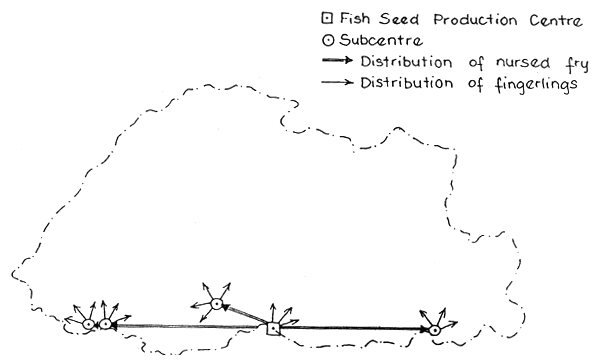
2. FISH SPECIES UNDER CULTIVATION AND THEIR FEEDING HABITS
2.1 Common carp
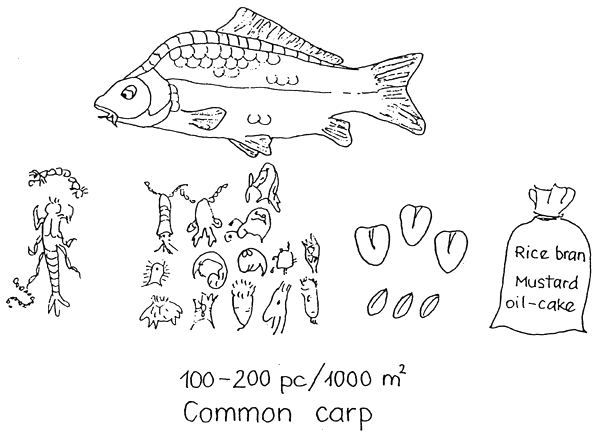
Common carp is a fast-growing omnivorous fish species. It is very important to include a certain number of this species in the total holding capacity of the pond, because they stir up the mud of the pond bottom making the pondwater muddy. This avoids light penetration as far as the bottom, thus controlling the mass production of aquatic vegetation.
The common carp is a bottom feeder and consumes insects, zooplankton, seeds of terrestrial plants, rice bran, wheat bran, crushed maize and mustard oil cake.
2.2 Grass carp
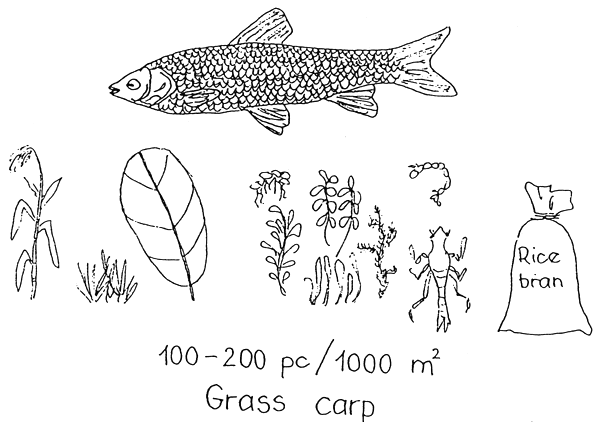
Grass carp is fast-growing and herbivorous. It can easily be fed with different kinds of soft, freshly chopped terrestrial plants. As it is a warmwater fish (temperatures of 19° to 30°C) its daily consumption is high, sometimes as much as 20–30% of its body weight. It usually feeds on grass, other terrestrial plants, aquatic vegetation, seeds of terrestrial plants and insects. It helps in the control of aquatic vegetation and can be grown together with other fish species.
2.3 Catla

Catla is one of the largest carp warmwater species. It grows fast in properly manured and fertilized ponds and feeds on zooplankton, phytoplankton and detritus.
2.4 Rohu
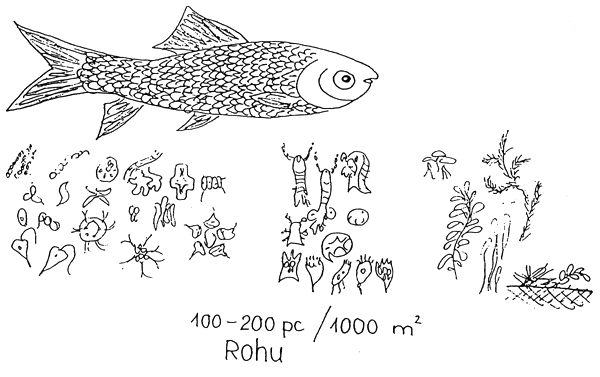
This fish species grows very well in properly manured ponds and it is one of the most valuable. It feeds on zooplankton, phytoplankton, aquatic macrovegetation and decayed macrovegetation.
2.5 Mrigal
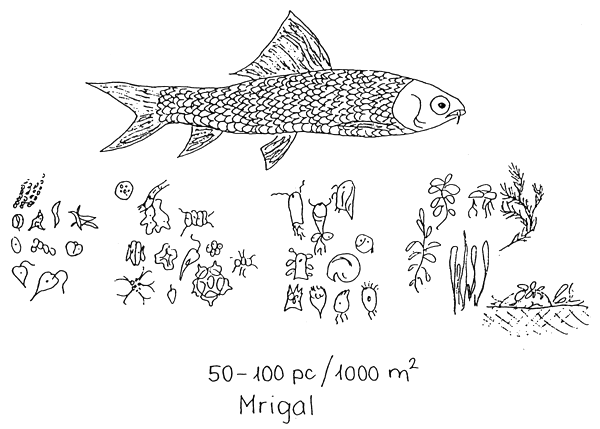
Mrigal is a well-growing warmwater fish. It usually feeds on phytoplankton, zooplankton, aquatic macrovegetation and decayed macrovegetation.
2.6 Silver carp
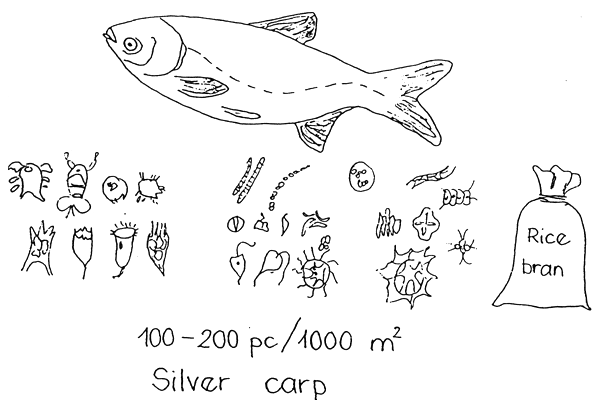
Silver carp is an important fish species and grows fast in properly fertilized ponds. Its main food is phytoplankton, but is also feeds on zooplankton, rice bran and other ground (powder-like) artificial feeds.
2.7 Bighead carp
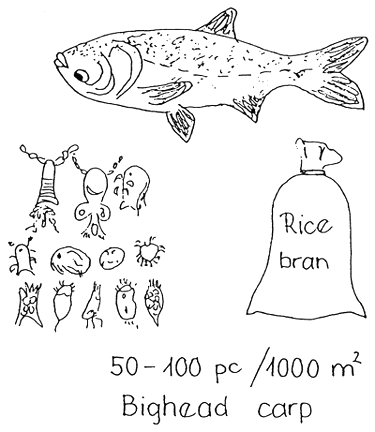
This is a voracious eater. It feeds mainly on zooplankton and powder-like artificial feeds.
3. DIFFERENT TYPES OF FISH PONDS, THEIR CONSTRUCTION AND MAINTENANCE
It is possible to construct fish ponds where clayey soil and enough water are available on the selected site. It must be accessible by road, and erosion and floods must be controllable.
Depending on the topographical conditions of the selected site it is possible to construct four types of ponds:
(1) Undrainable excavated ponds
This type of pond is simply excavated on plain areas. It is not completely drainable and hence cannot be dried.

(2) Drainable excavated ponds (A and B)
These ponds are more or less as shown above, except for the fact that they can be completely drained and dried when necessary.

(3) Barrage ponds (C)
These ponds are constructed in small valleys where only one side of the pond needs to be built. If the valley is long and narrow, a number of ponds can be made.
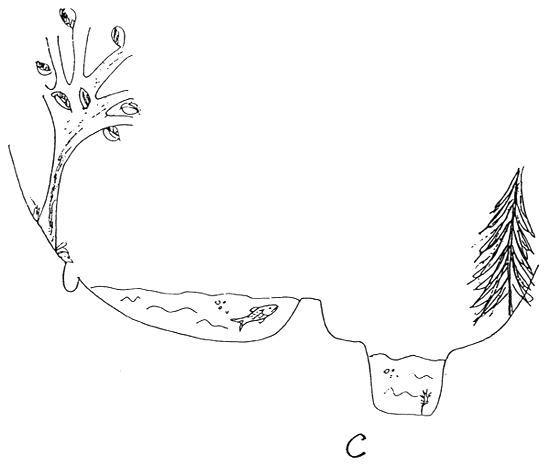
(4) Contour ponds (D)
This is a drainable fish pond bordered with dike on each side, and can be supplied with water from high turn-out canals or by using pumps.
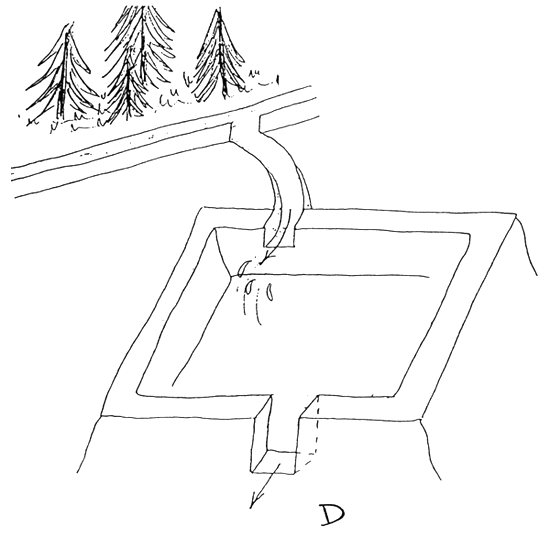
Selection of site
Selection of site is the most important decision to be taken in the construction of a pond system. If the area under decision is gravelly, sandy or peaty, it is not advisable to construct a pond there because there will be heavy seepage which cannot be controlled. This can be checked by making sample pits in the given area.
The water supply should also be checked. To fill the pond and maintain the water level, a well-sealed pond of 100 m2 surface requires 1 litre/min. More may be required at the end of the dry season.

It must also be taken into account that the pond should be constructed in a place where there is sufficient sunlight (for reasons described later). There should not be many trees surrounding the pond because the quality of water deteriorates by decaying leaves falling into the pond.
Construction of small fish ponds
When the size of pond is decided, certain factors must be taken into account, e.g., amount of fish and the topographical possibilities. If proper technology is applied, during one growing season (i.e., 6 months) about 20–25 kg of fish can be obtained from a pond area of 100 m2.
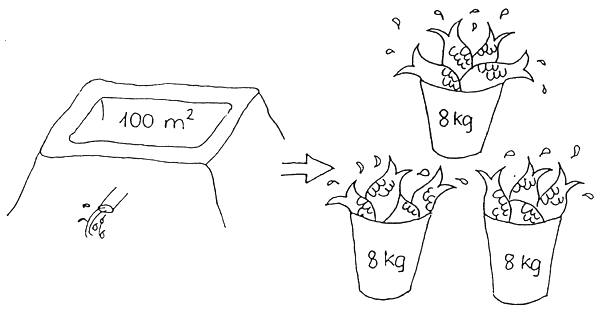
When it is decided where, which type and size of pond will be constructed, the area of the pond should be marked out. First, the selected area must be cleaned: the grasses, bushes and trees should be cleared properly including the roots of trees.

After all the above details have been completed, the pond is dug to the previously decided depth. Care should be taken not to dig as far as the stony or gravelly layer of the earth. A minimum 20–25 cm layer of clay should remain above the stony layer.
The excavated earth should be used for construction of dikes of the pond and must be compacted.

Depth of the pond
The depth of a pond should be more than 1 m. If the pond is too shallow, the sunshine can penetrate to the bottom and stimulate the growth of macrovegetation. This would create problems in handling the pond, and the nutrition requirement of the macrovegetation and its shading effect will decrease the plankton population, which consequently also leads to a decrease in fish production.
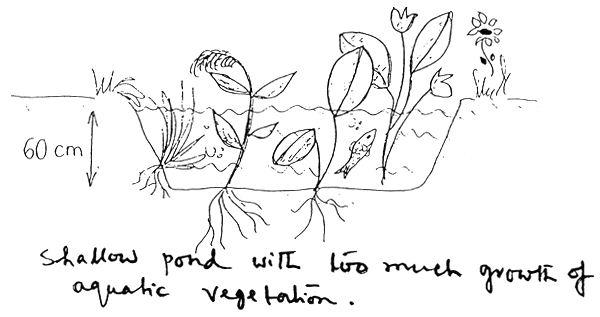
Water inlet and outlet
In the overall planning stage, it must be decided where to insert the water inlet and outlet structures in the dikes. These structures can be made either of concrete or of wood.
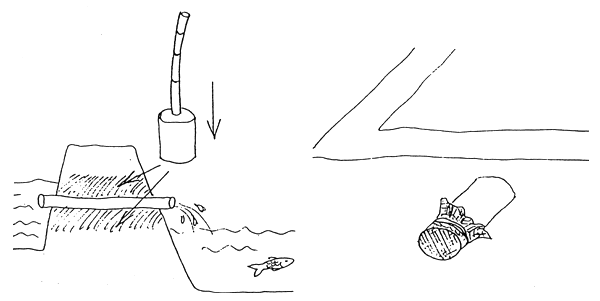
The inlet and outlet structures should include wooden boards to stop the passage of water and also wire netting. These nets serve to block the entrance of trash and waste or carnivorous fish and to avoid the escaping of cultivated fish. The mesh size of the net at the time of fitting should be like that of a mosquito net and later it can be larger. The diameter of the inlet and outlet pipes should not be less than 15–20 cm to help reduce the time needed to fill and drain the pond.
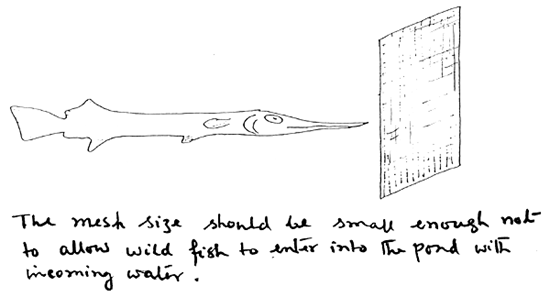
Maintenance of the ponds
The completed dikes should be planted with grass or covered with sods; as a covered dike is better protected against the erosion which could be caused by heavy rains.
A lot of mud accumulates at the bottom of the pond every year thus making the pond shallow. This accumulated mud contains decayed organic matter which is poisonous to the fish. To avoid this, the pond should be left empty to dry in the sun for about 1 ½ weeks each year. The soil bottom is then either dug or ploughed.
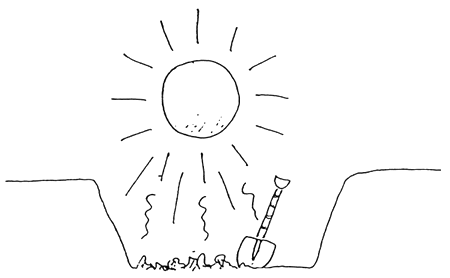
After 3–4 years the upper layer of the bottom should be removed from the pond for the abovementioned reasons. This soil contains large amounts of valuable organic materials which can serve as a fertilizer of the plough-lands used for any kind of agriculture.
4. NATURAL FOOD OF FISH AND MANURING OF PONDS
Different kinds of natural food
The very small plants and animals not visible to the naked eye are the most important food of fish. They reproduce and grow in the water if there is enough sunlight and the pond is well fertilized.
Methods of manuring
Food of fish is obtained by manuring the pond water. Manuring the pond helps the production of algae (small plants) which are eaten by some fish species, and of plankton (small animals) which is the main food of the majority of cultivated fish. Small animal-like earthworms, larvae of insects and insects develop and are eaten voraciously by fish.
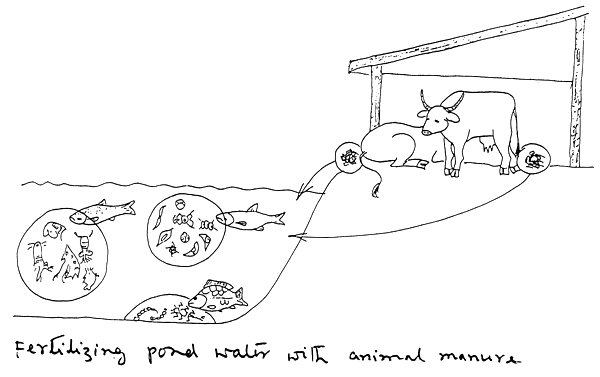
There is enough natural food in the pond water when the water is dark green or greenish-brown, and if the fisherman cannot see his hand when it is immersed about 12–15 cm into the water. Many small moving animals can be seen in a glass of water taken from the pond.
To achieve such conditions about 2–5 kg manure/100 m2 should be spread every day on the pond surface. It is best to use pig and chicken manure, but cattle manure is also suitable.
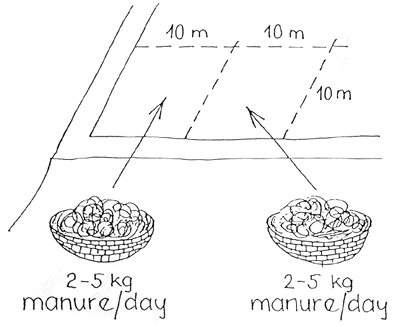
If the water is over-manured, this can be detrimental for the fish because the small plants and animals developed by the amount of manure consume the oxygen from the water and thereby oxygen deficiency can occur. This phenomenon happens usually at night and in the early morning hours at sunrise. When such a situation arises in the pond, the fish are seen near the surface of the water and try to take additional oxygen from the air. In such a situation, the pond must be supplied with freshwater as soon as possible, and it is advisable to stop feeding and manuring for 2–4 days.
NOTE: When fish are fed with rice bran, which usually floats, and the fish consume it on the surface during bright sunlight, this must not be mistaken for oxygen shortage.
5. ARTIFICIAL AND SUPPLEMENTARY FEED
Though the natural food (plankton, insects) is the most important food for fish, supplementary feeds have to be used to reach higher production or to enhance culture of bigger quantities of fish in the same pond.
Different kinds of artificial feeds are:
seeds of terrestrial plants (maize, wheat, millet, rice bran)
oil cakes (mustard oil cake) - only for fish above 100 g average weight
terrestrial and aquatic plants (grass, banana leaves, maize leaves)
kitchen refuse
insects from air attracted by light at night.
Schedule of feeding
Feed should be given once or twice a day, in the morning between 06.00 and 07.00 h, and in the afternoon. The feeding place should be marked with a peg. The feed should be thrown into the water every day at the same time at the feeding place.

The problems of both under- and over-feeding should be kept in mind. Only that amount of feed should be given which the fish consume in 2 hours. The consumption of feed can be checked with a special long-handled, small mesh size scoopnet.

If the amount of feed is consumed very quickly (10–15 min), the ration should be increased, and if the amount is not consumed in 2 hours, it is advisable to decrease it.
The rice bran (the most important feed in fish culture) is very light and will always tend to float on the surface. So if the weather is windy, it is advisable to mix it with wet clay and throw it into the water. (It is calculated that about 6–7 kg of rice bran will give 1 kg of fish meat product.)
During the first month of market-size fish production it is not necessary to feed the fish, but proper manuring of the pond is very important.
The daily feed ratio is as follows:
| second month | 0.5 kg/100 m2 |
| third month | 1.9 kg/100 m2 |
| fourth month | 1.5 kg/100 m2 |
| and after | 2.0 kg/100 m2 |
If other feeds (cereals) are used, the grains of cereals are given to the fish in ground or whole form depending on the size of fish. If cereals (wheat, maize, etc.) are used, only half the quantity of rice bran is given.
Oil cakes are also very useful feeds for the fish: 40–50% oil cake and 60–50% rice bran or wheat. It is not advisable to feed the fish with mustard oil cake before they reach three months of age.
When grass carps are fed with different kinds of plants (grass, aquatic plants, leaves of different trees), it is advisable to use a floating bamboo frame as a feeding place. About 30–50 kg of plants will give 1 kg of grass carp meat.
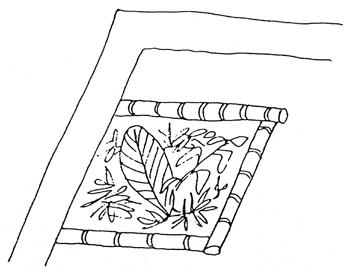
During the night it is useful to hang a lemp over the surface of the pond water. It attracts the insects and lots of them fall into the water and are consumed by the fish.

6. STOCKING DENSITY AND PROPORTION
Polyculture
As already stated, different fish species have different feeding habits. Some of them consume plankton, others consume insects or decayed or/and living vegetation. Some are surface-feeders, others are bottom- or column-feeders.
For the proper utilization of different sources of natural food in the pond, it is advisable to grow fish in polyculture, that is, to culture as many fish species as possible in one pond, in an adequate stocking ratio.
A commonly applied stocking ratio would be 100–200 fingerlings of common carp, grass carp, silver carp and rohu in a pond of 1 000 m2. In the same pond, 50–100 individuals/1 000 m2 of catla, mrigal and bighead carp can be kept together with the abovementioned species.
Growth and production of fish
When a pond is stocked with a lower quantity of fish, they grow faster, because they have more natural food; but the total production of the pond will not be high. When the pond is overcrowded, the fish grow much more slowly due to the fact that they have less natural food (it may not be possible to supplement the necessary natural food with artificial feed, as it does not contain all the materials needed for optimum fish growth.
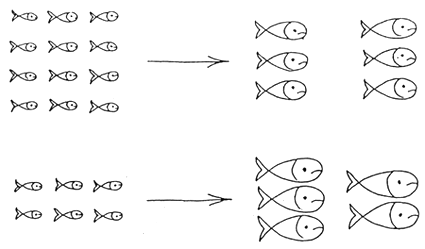
It is advisable to stock 0.5–2.0 fingerlings/1 m2 (i.e., 500–2 000 individuals/1 000 m2). Higher stocking densities can be applied only in such a case (1 500–2 000 individuals/1 000 m2), if the method of partial harvesting is applied. (This means the harvests which decrease the quantity of fish in the pond from the third month after stocking.)
If the stocking density if 1 fish/m2, fish can reach 0.3–0.6 kg average weight in a 6–7 months growing period, if proper manuring and feeding are ensured.
Time of stocking and harvesting
Distribution of fingerlings from the Centre and from sub-centres can begin about 1 or 1 ½ months after reproduction. Distribution is as follows:
| common carp | - | April/May |
| silver carp | - | June |
| grass carp | - | June |
| bighead carp | - | June |
| catla | - | July |
| rohu | - | July |
| mrigal | - | July |
These species should be stocked continuously to the fish ponds, in the abovementioned quantities. It is impractical to overstock the ponds with the small fish received first from the Centre, as in that case the growth of later-stocked fish species will be slow.
From the time of distribution till the end of February the fish can be grown to market-size, and during March and April the ponds can be dried and reconstructed.
7. INTEGRATED FISH FARMING
Fish culture together with other animals
In order to produce adequate amounts of natural food, the pond should be fertilized daily. Methods have been developed to have enough manure in the pond water without daily fertilization; this can be done through integrated fish-farming. Integrated fish-farming is the culture of terrestrial animals (pigs, ducks, chickens) near or above the fish ponds; their droppings fall into the pond serving as manure.
Fish-cum-pig culture
For the proper fertilization of the pond by pig manure, it is advisable to use 8 smaller (20–30 kg average weight) or 4 bigger (60–80 kg average weight) pigs in a 1 000 m2 pond. The pigstall should be built either near or above the water, close to the inlet monk. In this case the manure will be distributed by the inlet water all over the pond and not accumulate in one place.
Bricks, wood or bamboo are the best materials for building pigstalls. In order to ensure that all the manure goes into the pond, the floor of the pigstall should be sloping and a small gap be made if the floor is made of wooden planks.
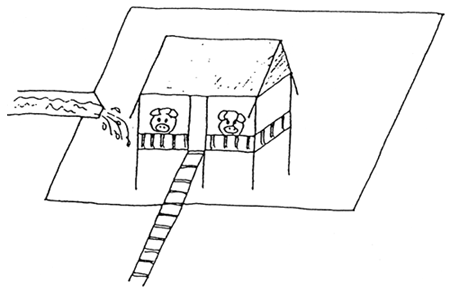
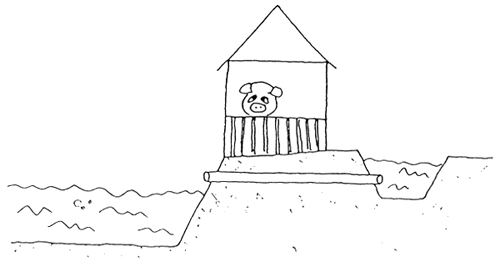
8. HARVESTING AND TRANSPORTATION OF FISH
Methods of harvesting
When the main target of production is to provide enough fish for the family, it is best to stock a little more fish and apply the method of partial (step-by-step) harvesting. This method gives a continuous supply of fish for the family, and also improves conditions for the rest of the fish to grow (with more natural food).
When the chosen target of fish production is to sell them on the market, it is better to wait to harvest until the end of the season, to let the fish reach market-size, and thus fetch a higher price.
If the partial harvesting method is applied, stocking density should b 1–1.5 individuals/m2. If the total harvesting method is applied, the stocking density should be only 1 fingerling/2 m2.
Transport of fish
If there are difficulties in transporting the live fish to the market, it is advisable to cut the fish and remove the intestines and gills soon after harvesting. They should be transported in as low a temperature as possible, protecting them from direct sunlight, and packing with ice if available.
9. DIFFERENT METHODS FOR PRESERVING FISH
Fish smoking
Fish smokers can be constructed of two single types. The first is the drum-type oven and the other one is the box-type of smoker.
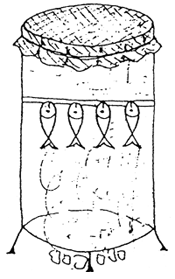 | 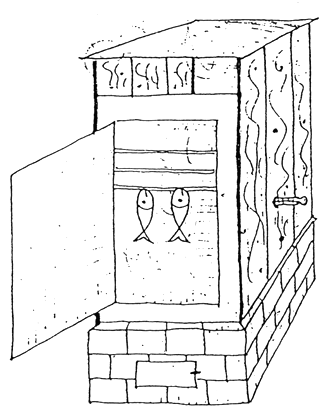 |
Smoking for one-week preservation -
The fish should be cleaned by removing the internal organs and scales, and washed properly.
Then the fish is dipped in a salt solution (the solution is prepared by dissolving 1 kg of common salt in 9–10 litres of water). The fish should be kept in this solution for 12–15 hours.
The fish is removed from the solution and dried by wiping. It is hung in the smoker which is in the process of working.
At the beginning the smoking temperature should be 40°C for one hour. (On the fire made of 2–3 bigger pieces of wood, an adequate amount of sawdust should be added in order to suppress the fire and obtain only smoke, the temperature of which is 40°C.)
After an hour of continuous smoking, the fire should be allowed to flame, and the temperature of the smoke, measured at about 1 m above the fire bed, should be brought to 60°–70°C for another half hour.
For the next three hours the temperature of the smoker should again be brought down to 40°C. This is done by covering the fire with sawdust.
After this process the fish should be cooled by hanging them in an enclosure, the walls of which are made of mosquito net, and free air passage should be allowed.
The storage of the smoked fish should also be as described above in 7.
Method for preserving fish meat for more than one month -
The fish should be cleaned by removing the head, the internal organs and the scales, and washed properly.
Then the fish is put in dry salt, and salt is also put into the body cavity of the fish. For 1 kg of fish 0.5 kg of salt should be used. The fish is kept in the salt for 7–8 days.
The fish is removed from the salt and put in clean water for 10–20 hours (depending on the temperature of the water: in warm water 10 hours, in cold water 20 hours).
Then the fish is smoked at a temperature of 30°–35°C (this is brought about by using less firewood and more sawdust in the smoker). The smoking period lasts 4 days.
Drying of fish
The fish should be cut, the intestines removed, and cleaned.
Two or 3 backbones should be removed and 2–3 incision (longitudinal cuts) made on each side of the fish. The skin should not be damaged.
Each fish should be sprinkled with salt. (For 4 kg of fish 1 kg of common salt is needed.)
One day and 2 nights are enough to keep the smaller fish in the salt.
The excess salt should be washed out of the fish (2–3 hours are enough for washing them in running water).
Both sides of the fish have to be dried on the rocks.
Dry the fish till it cannot be compressed between two fingers (about 3 days).
Store the fish under mosquito net.
Preparation of the dragnet for fishing
It is best to make a net of about 10–15 m long for harvesting the small fish ponds. The depth should be 2–2.5 m and the mesh size 1.5 cm. (About 3 kg of plastic yarn are needed for this purpose.)
The tools for preparing the fishing net should be made of wood or bamboo.
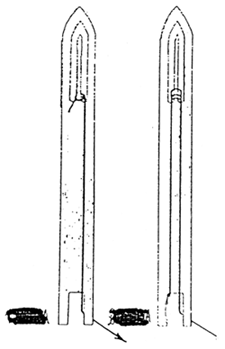 |  |
Figures 1–4 show how to begin the netmaking. Figures 5–8 show how to make the first mesh.
The first line which is seen in Figures 9, 10 and 11 are the depth of the dragnet. This line is repeated several times until the desired length of net is reached.
